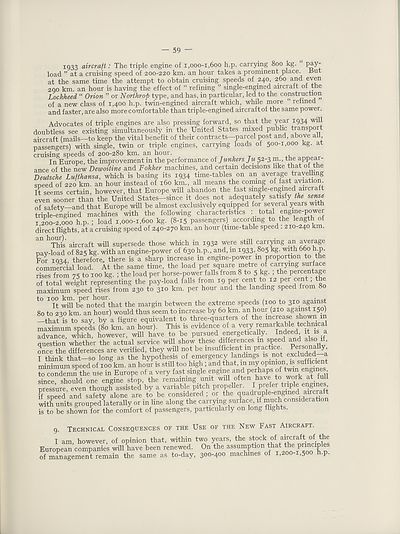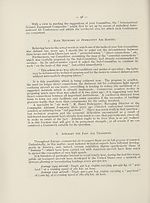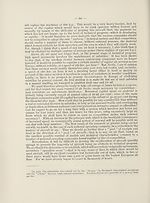Download files
Complete book:
Individual page:
Thumbnail gallery: Grid view | List view

59 —
1933 aircraft : The triple engine of 1,000-1,600 h.p. carrying 800 kg. P^Y*
load ” at a cruising speed of 200-220 km. an hour takes a prominent place. But
at the same time the attempt to obtain cruising speeds of 240, 260 and even
2oo km. an hour is having the effect of “ refining ” single-engined aircraft of the
Lockheed “ Orion ” or Northrop type, and has, in particular, led to the construction
of a new class of 1,400 h.p. twin-engined aircraft which, while more “ refined
and faster, are also more comfortable than triple-engined aircraft of the same power.
Advocates of triple engines are also pressing forward, so that the year 1934 will
doubtless see existing simultaneously in the United States mixed public transport
aircraft (mails—to keep the vital benefit of their contracts—parcel post and, above all,
passengers) with single, twin or triple engines, carrying loads of 500-1,000 kg. at
cruising speeds of 200-280 km. an hour. T ,,
In Europe, the improvement in the performance of Junkers Ju 52-3 m., the appear¬
ance of the new Dewoitine and Fokker machines, and certain decisions like that ol the
Deutsche Lufthansa, which is basing its 1934 time-tables on an average travelhng
sneed of 220 km. an hour instead of 160 km., all means the coming of fast aviation.
It seems certain, however, that Europe will abandon the fast smgle-engined aircraft
even sooner than the United States—since it does not adequately satisfy the sense
of safetv—and that Europe will be almost exclusively equipped for several years with
triple-engined machines with the following characteristics : total engine-power
1 200-2,000 h.p. ; load 1,000-1,600 kg. (8-15 passengers) according to the length of
direct flights, at a cruising speed of 240-270 km. an hour (time-table speed . 210 240 km.
an hour). ^ supersec|e those which in 1932 were still carrying an average
pay-load of 825 kg. with an engine-power of 630 h.p., and, in 1933. 805 kg. with 660 h.p.
For icm therefore, there is a sharp increase m engine-power in proportion to the
commercial load. At the same time, the load per square metre of carrying surface
rises from 75 to 100 kg. ; the load per horse-power falls from 8 to 5 kg. , the percentage
of total weight representing the pay-load falls from 19 per cent to 12 per cent , the
maximum speed rises from 230 to 310 km. per hour and the landing speed from 80
t0 1 It will be noted that the margin between the extreme speeds (100 to 310 against
80 to 230 km. an hour) would thus seem to increase by 60 km. an hour (210 against 150)
—that is to say, by a figure equivalent to three-quarters of the increase shown
maximum speeds (80 km. an hour). This is evidence of a very remarkable technical
advance which, however, will have to be pursued energetically. Indeed it is a
question whether the actual service will show these differences m speed and also if,
once the differences are verified, they will not be insufficient in practice^ Pe^ona y,
I think that—so long as the hypothesis of emergency landings is not exclude <
minimum speed of 100 km. an hour is still too high ; and that, in my opinion is sufficient
to condemn the use in Europe of a very fast single engine and perhaps of engi e
since should one engine stop, the remaining unit will often have to work at full
pressure, even though assisted by a variable pitch propeller. I prefer triple engines
If speed and safety alone are to be considered ; or the quadruple-engmed aircraft
with units grouped laterally or in line along the carrying surface, if much consideration
is to be shown for the comfort of passengers, particularly on long flights.
9. Technical Consequences of the Use of the New Fast Aircraft.
I am, however, of opinion that, within two years, the stock of aircraft of the
European companies will have been renewed. On the assumption fat the principles
of management remain the same as to-day, 300-400 machines of 1,200-1,500 h.p.
1933 aircraft : The triple engine of 1,000-1,600 h.p. carrying 800 kg. P^Y*
load ” at a cruising speed of 200-220 km. an hour takes a prominent place. But
at the same time the attempt to obtain cruising speeds of 240, 260 and even
2oo km. an hour is having the effect of “ refining ” single-engined aircraft of the
Lockheed “ Orion ” or Northrop type, and has, in particular, led to the construction
of a new class of 1,400 h.p. twin-engined aircraft which, while more “ refined
and faster, are also more comfortable than triple-engined aircraft of the same power.
Advocates of triple engines are also pressing forward, so that the year 1934 will
doubtless see existing simultaneously in the United States mixed public transport
aircraft (mails—to keep the vital benefit of their contracts—parcel post and, above all,
passengers) with single, twin or triple engines, carrying loads of 500-1,000 kg. at
cruising speeds of 200-280 km. an hour. T ,,
In Europe, the improvement in the performance of Junkers Ju 52-3 m., the appear¬
ance of the new Dewoitine and Fokker machines, and certain decisions like that ol the
Deutsche Lufthansa, which is basing its 1934 time-tables on an average travelhng
sneed of 220 km. an hour instead of 160 km., all means the coming of fast aviation.
It seems certain, however, that Europe will abandon the fast smgle-engined aircraft
even sooner than the United States—since it does not adequately satisfy the sense
of safetv—and that Europe will be almost exclusively equipped for several years with
triple-engined machines with the following characteristics : total engine-power
1 200-2,000 h.p. ; load 1,000-1,600 kg. (8-15 passengers) according to the length of
direct flights, at a cruising speed of 240-270 km. an hour (time-table speed . 210 240 km.
an hour). ^ supersec|e those which in 1932 were still carrying an average
pay-load of 825 kg. with an engine-power of 630 h.p., and, in 1933. 805 kg. with 660 h.p.
For icm therefore, there is a sharp increase m engine-power in proportion to the
commercial load. At the same time, the load per square metre of carrying surface
rises from 75 to 100 kg. ; the load per horse-power falls from 8 to 5 kg. , the percentage
of total weight representing the pay-load falls from 19 per cent to 12 per cent , the
maximum speed rises from 230 to 310 km. per hour and the landing speed from 80
t0 1 It will be noted that the margin between the extreme speeds (100 to 310 against
80 to 230 km. an hour) would thus seem to increase by 60 km. an hour (210 against 150)
—that is to say, by a figure equivalent to three-quarters of the increase shown
maximum speeds (80 km. an hour). This is evidence of a very remarkable technical
advance which, however, will have to be pursued energetically. Indeed it is a
question whether the actual service will show these differences m speed and also if,
once the differences are verified, they will not be insufficient in practice^ Pe^ona y,
I think that—so long as the hypothesis of emergency landings is not exclude <
minimum speed of 100 km. an hour is still too high ; and that, in my opinion is sufficient
to condemn the use in Europe of a very fast single engine and perhaps of engi e
since should one engine stop, the remaining unit will often have to work at full
pressure, even though assisted by a variable pitch propeller. I prefer triple engines
If speed and safety alone are to be considered ; or the quadruple-engmed aircraft
with units grouped laterally or in line along the carrying surface, if much consideration
is to be shown for the comfort of passengers, particularly on long flights.
9. Technical Consequences of the Use of the New Fast Aircraft.
I am, however, of opinion that, within two years, the stock of aircraft of the
European companies will have been renewed. On the assumption fat the principles
of management remain the same as to-day, 300-400 machines of 1,200-1,500 h.p.
Set display mode to:
![]() Universal Viewer |
Universal Viewer | ![]() Mirador |
Large image | Transcription
Mirador |
Large image | Transcription
Images and transcriptions on this page, including medium image downloads, may be used under the Creative Commons Attribution 4.0 International Licence unless otherwise stated. ![]()
| League of Nations > Communications and transit > Economics of air transport in Europe > (95) |
|---|
| Permanent URL | https://digital.nls.uk/194987833 |
|---|
| Shelfmark | LN.VIII |
|---|
| Description | Over 1,200 documents from the non-political organs of the League of Nations that dealt with health, disarmament, economic and financial matters for the duration of the League (1919-1945). Also online are statistical bulletins, essential facts, and an overview of the League by the first Secretary General, Sir Eric Drummond. These items are part of the Official Publications collection at the National Library of Scotland. |
|---|---|
| Additional NLS resources: |
|

